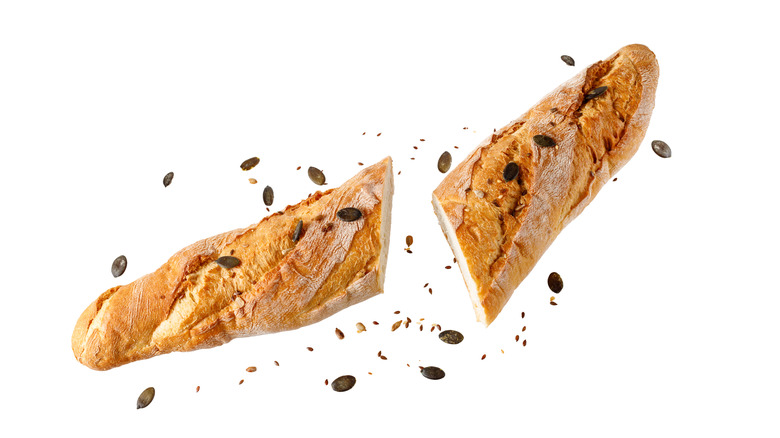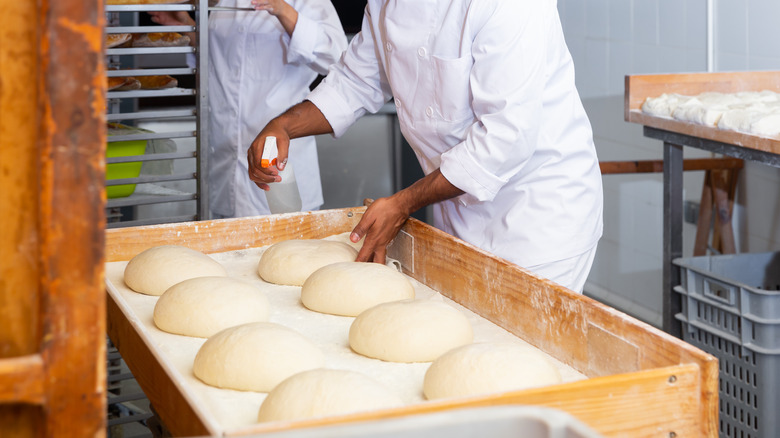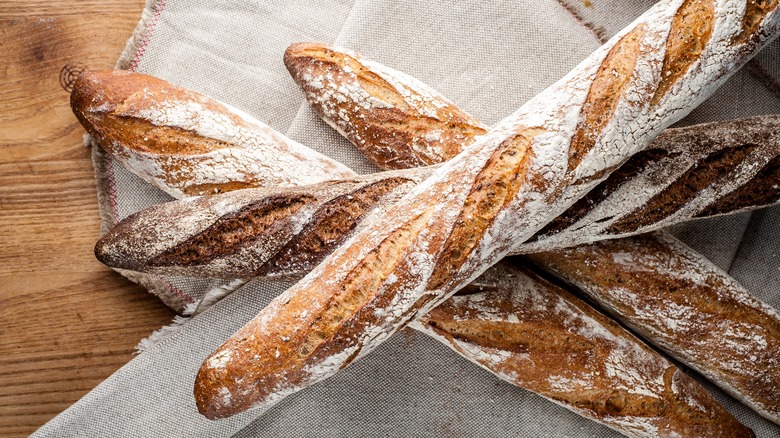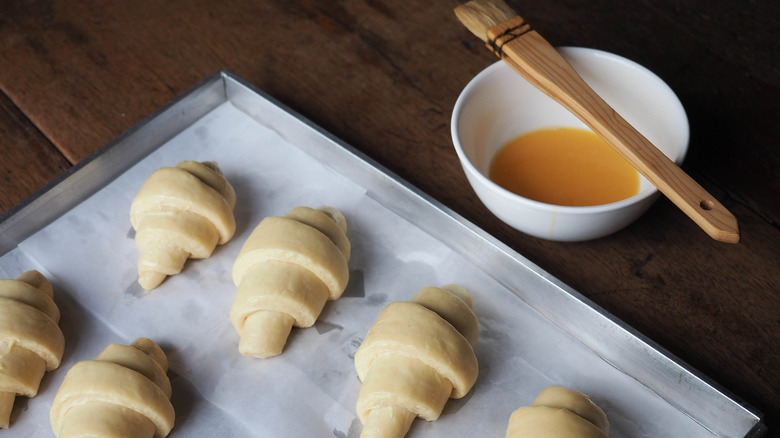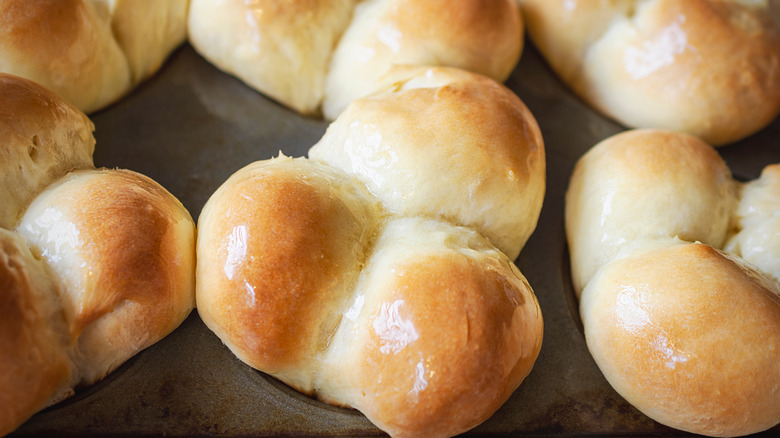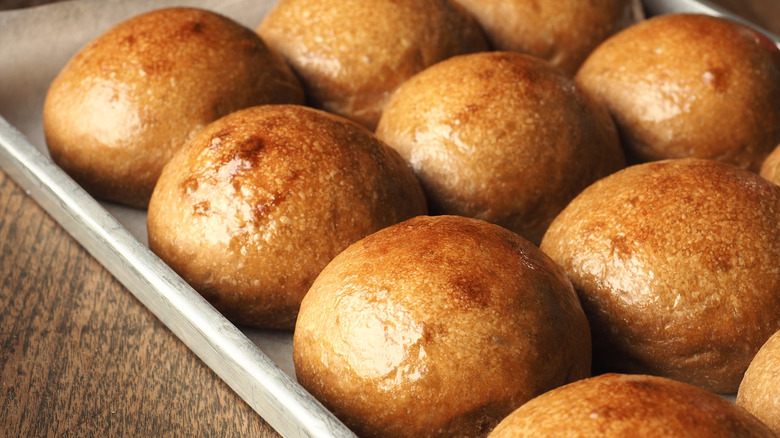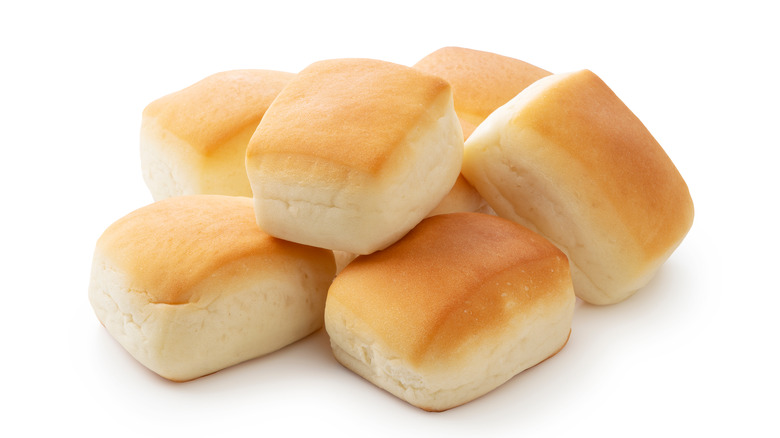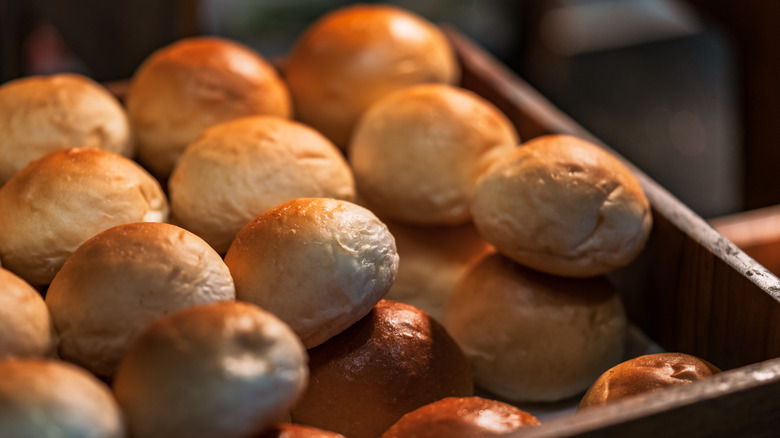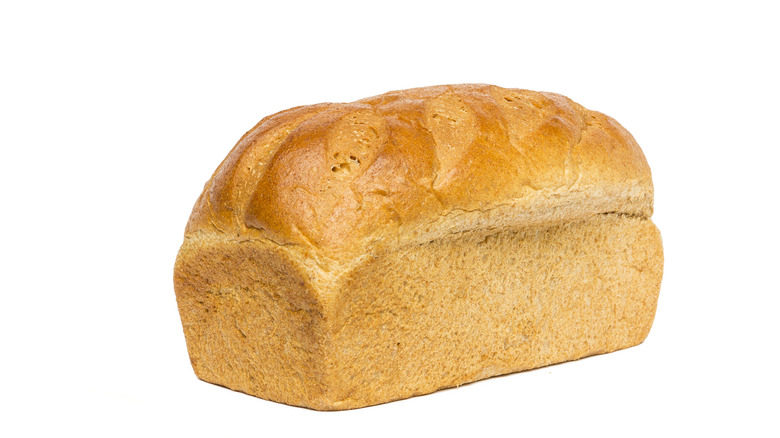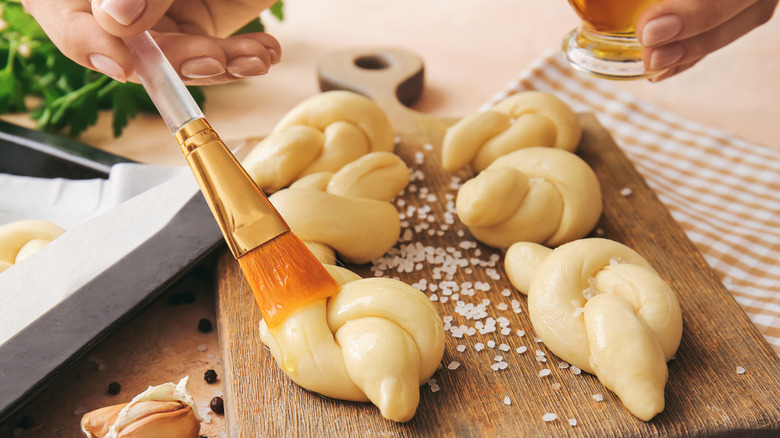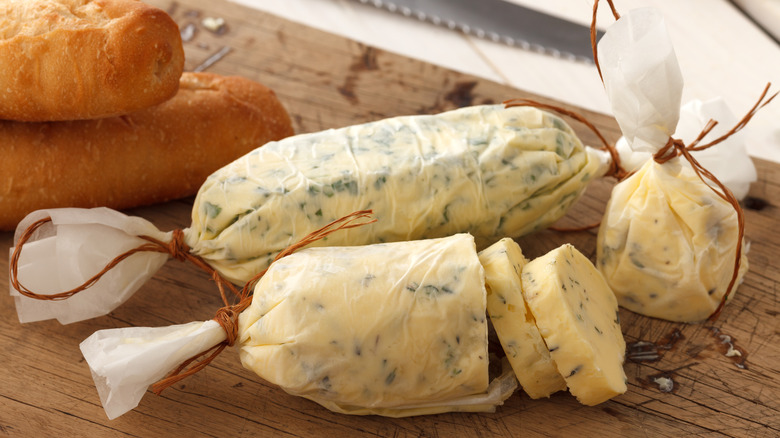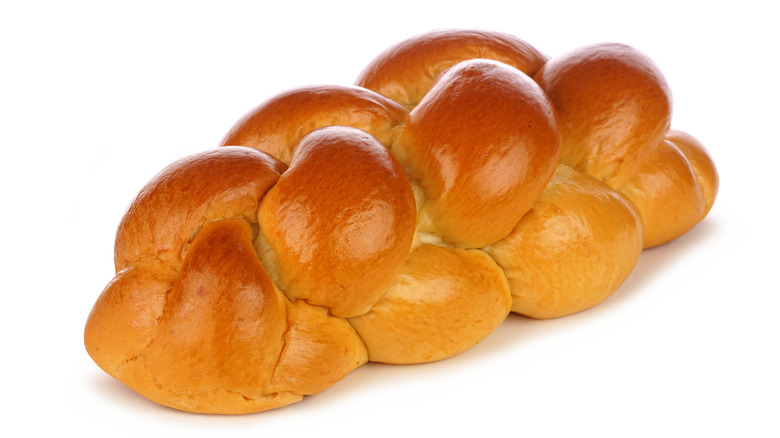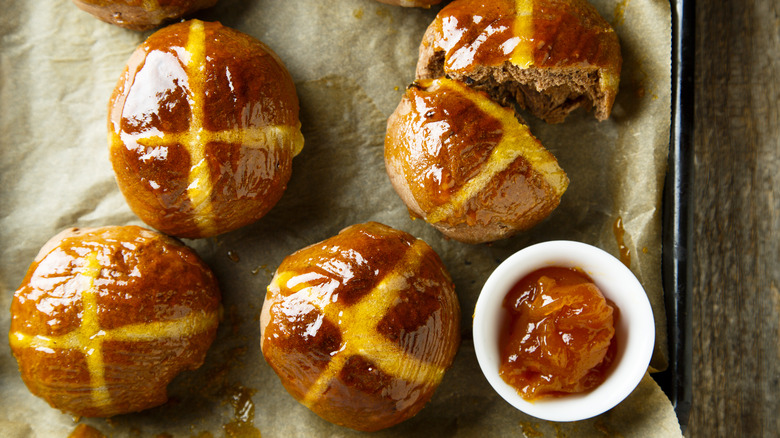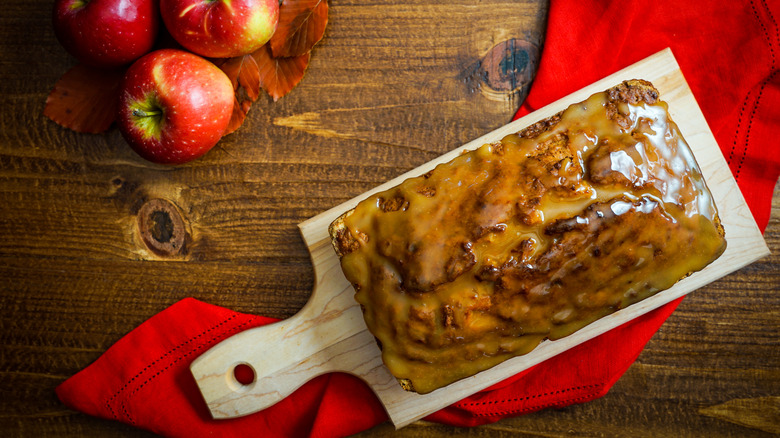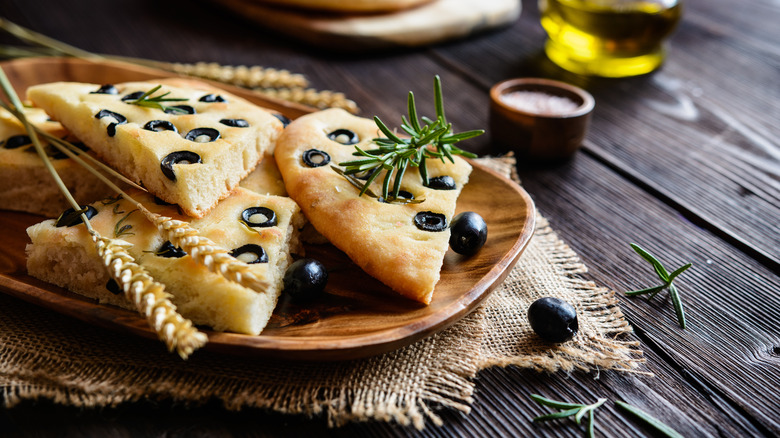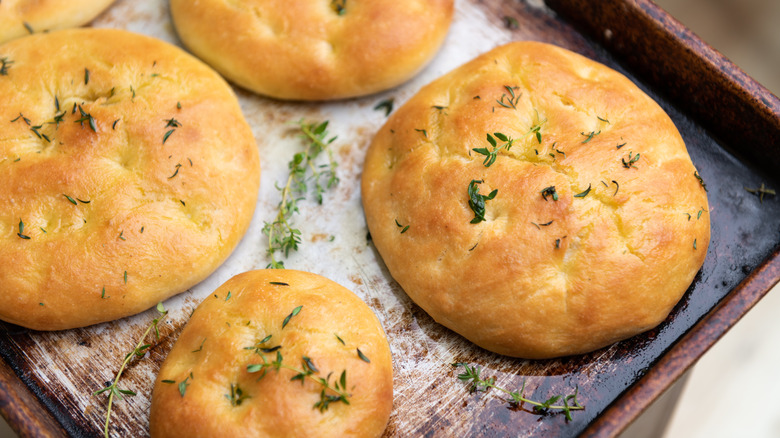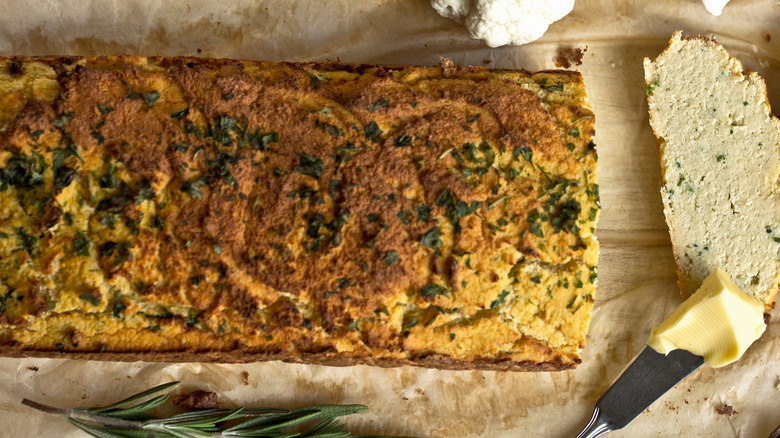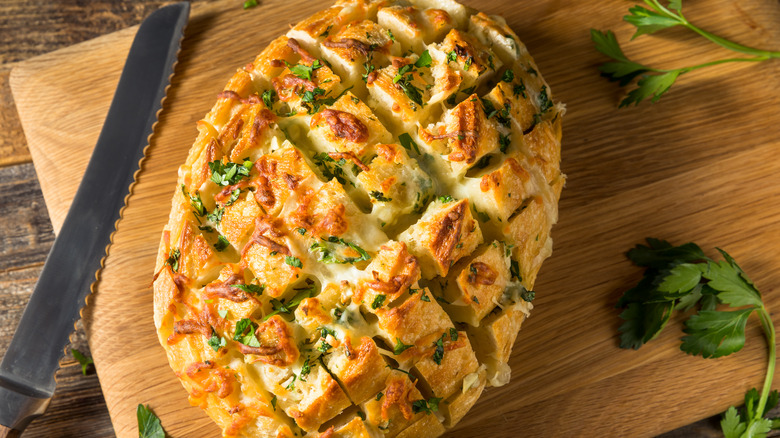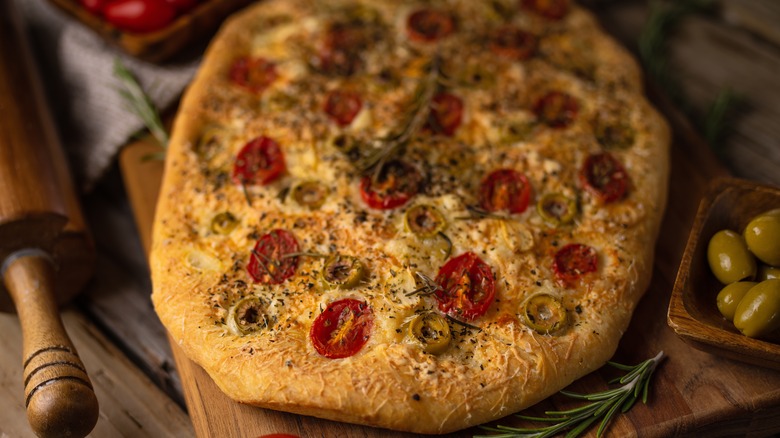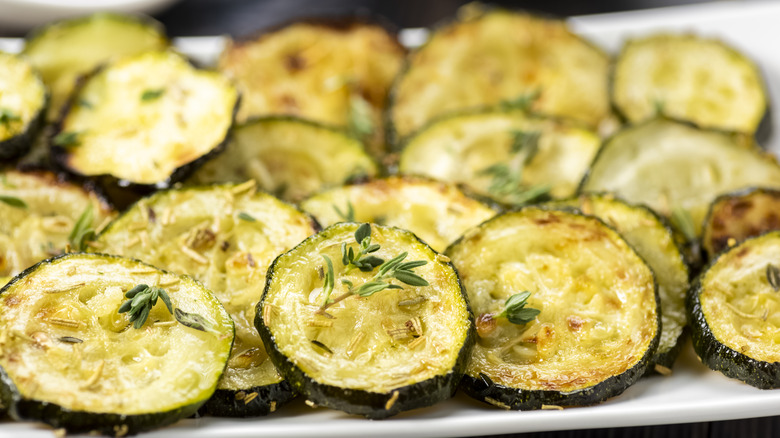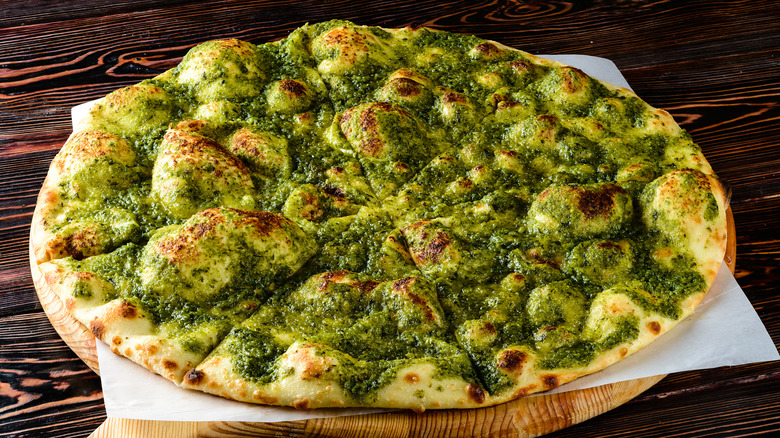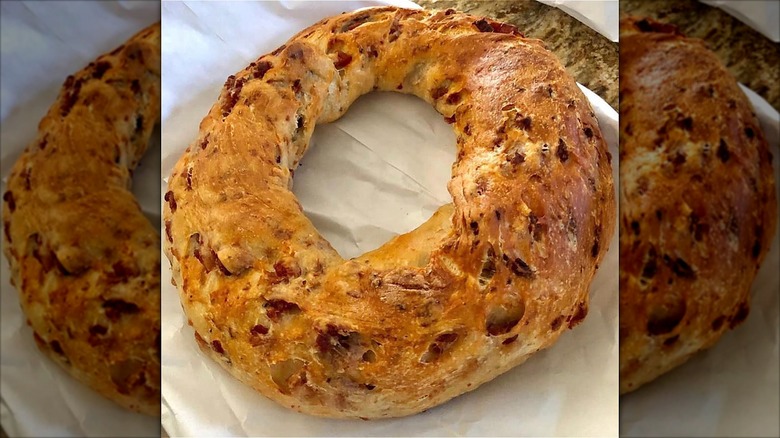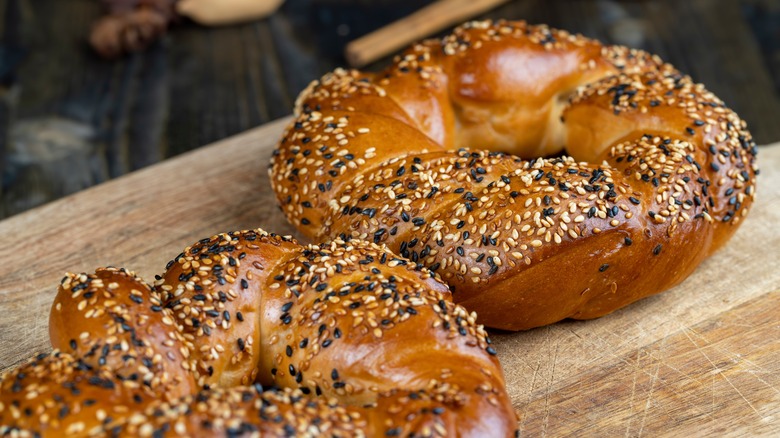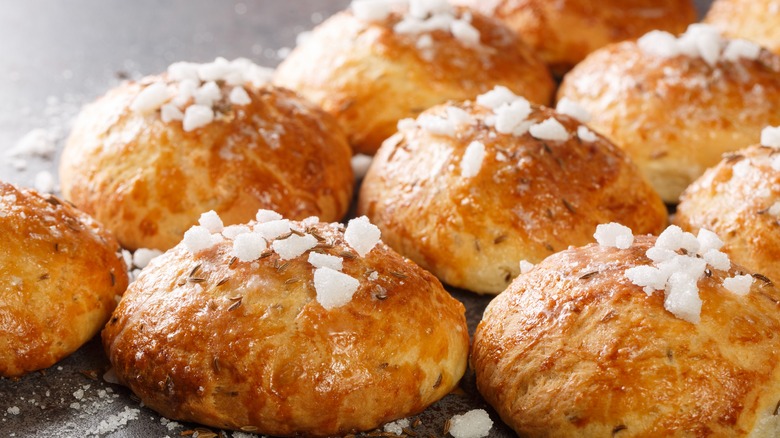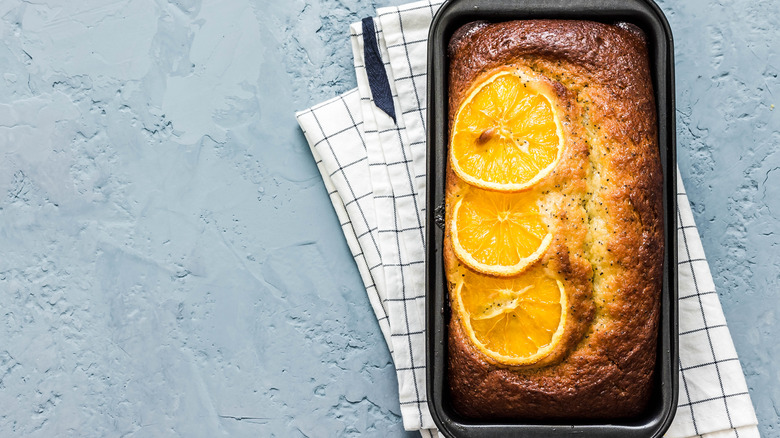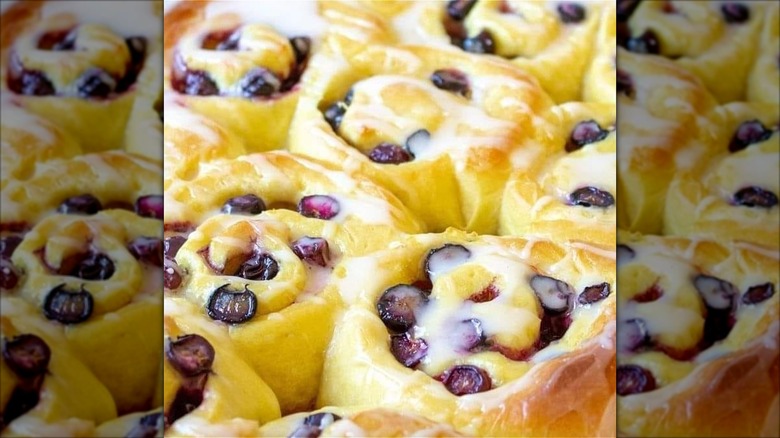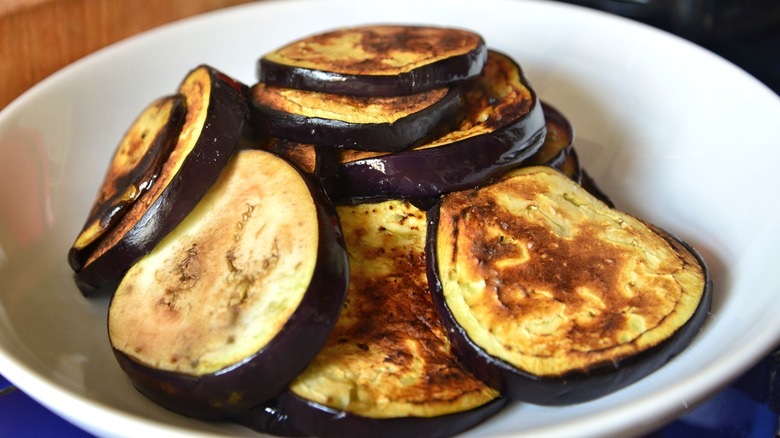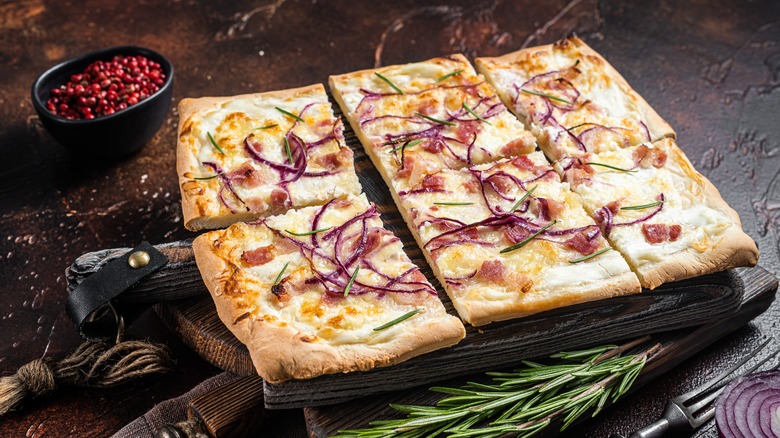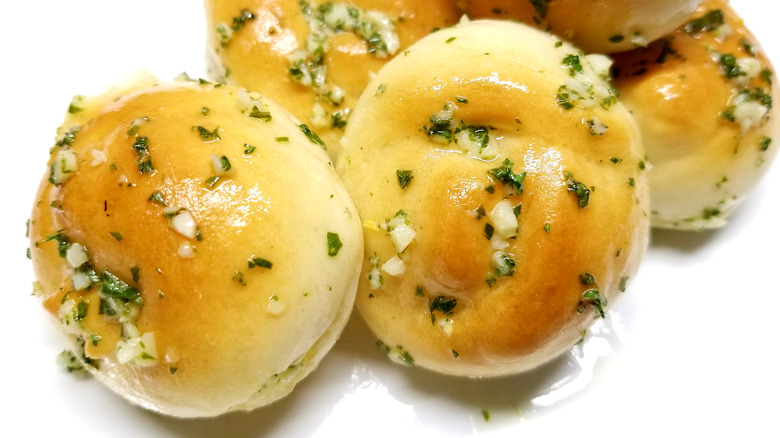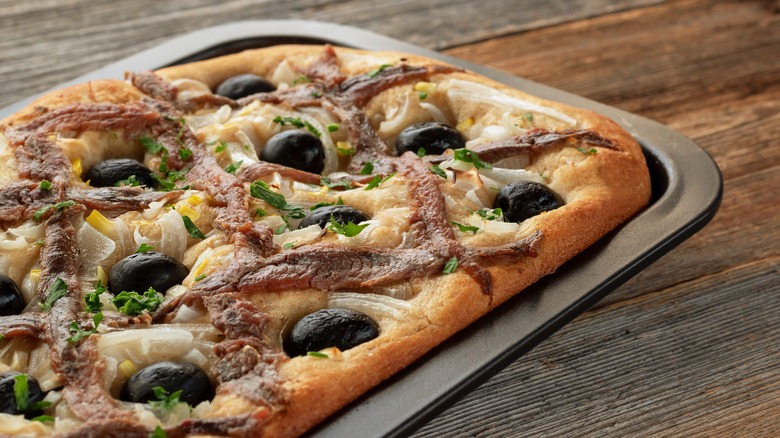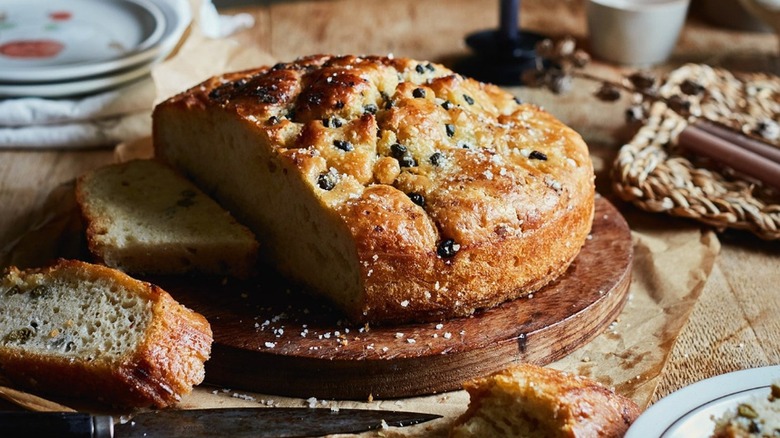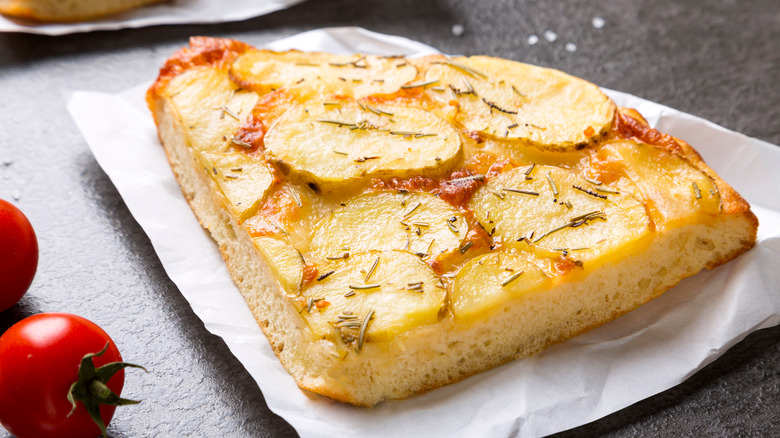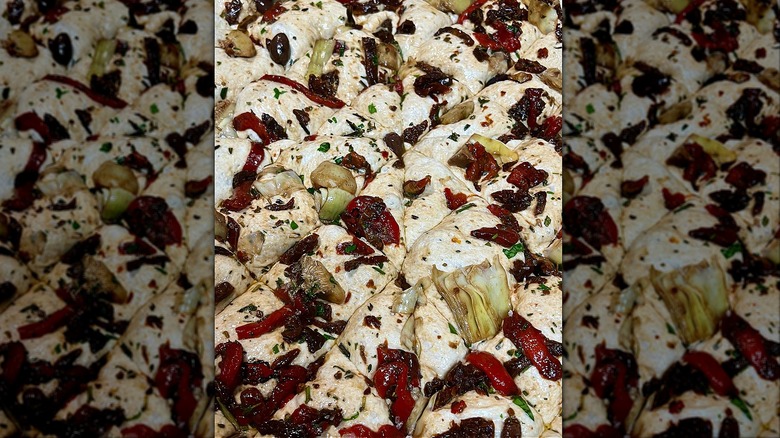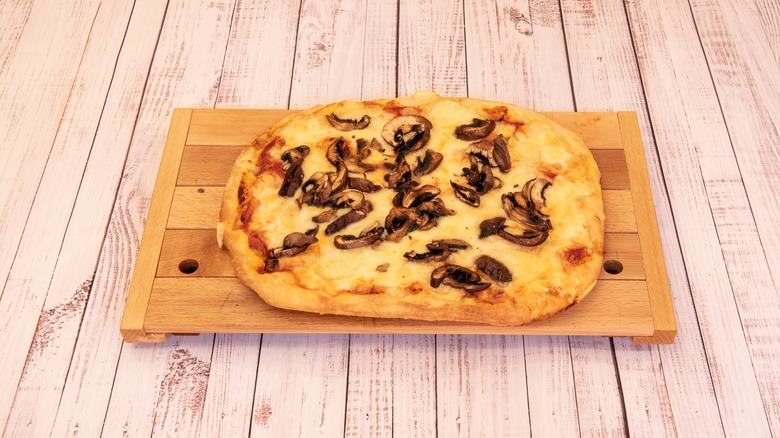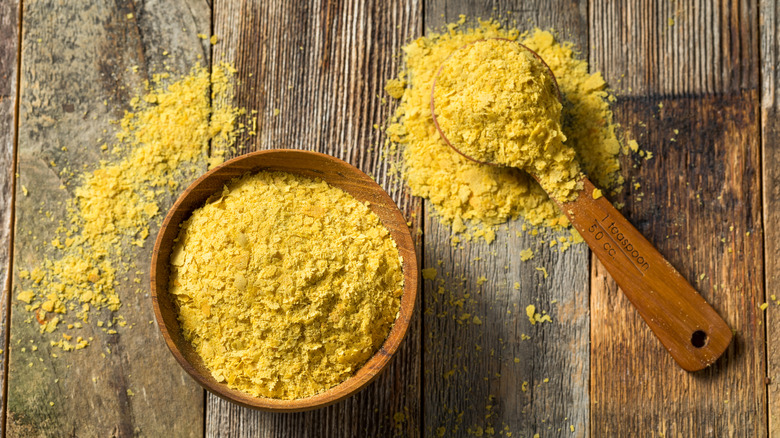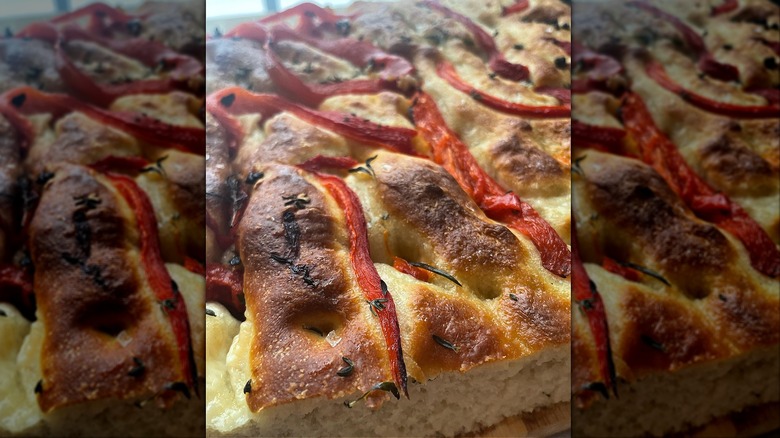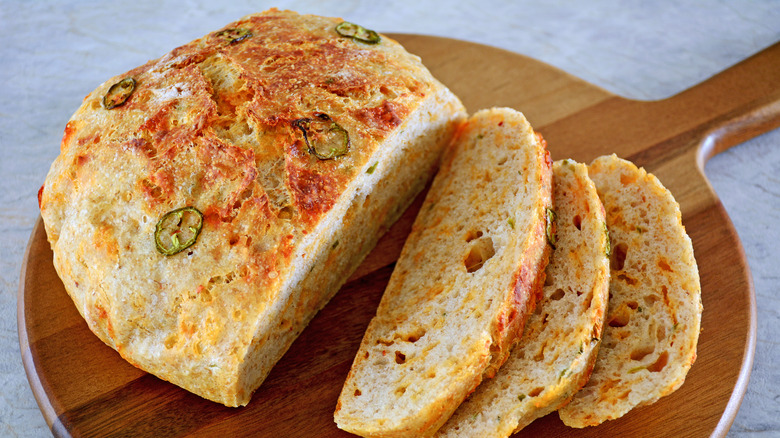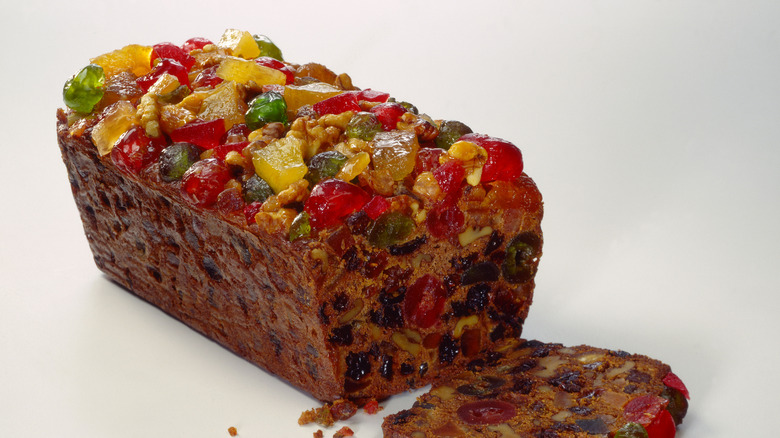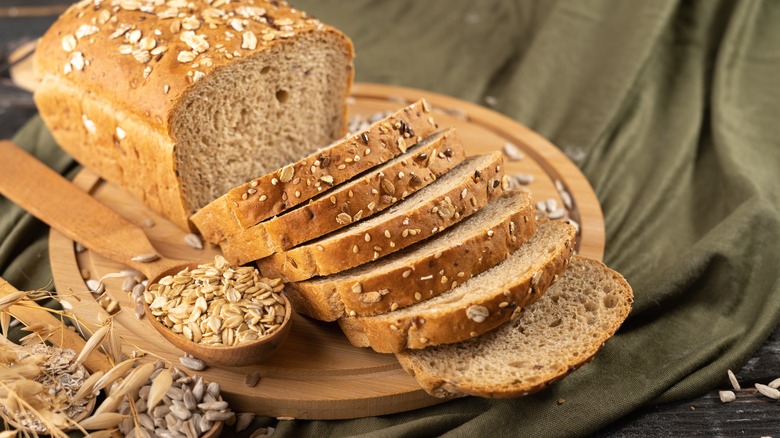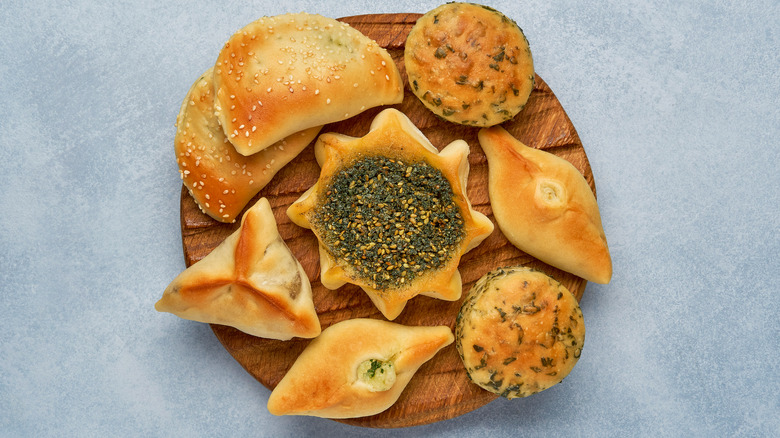39 Bread Crust Toppings That Will Take Your Loaf To The Next Level
I have mastered many skills in the almost two decades I have worked as a chef. One of these is the art of bread baking. Baking is often a science, but when working with yeast, measurements become less crucial than intuition. Yeast is a living, breathing entity with a personality of its own, and it takes some finesse to discover what works and what doesn't when feeding this organism and cultivating the ideal loaf.
Every loaf of bread is a unique creation, calling for its adornments. Adding a topping is among the best ways to infuse bread with visual, aromatic, textural, and flavorful interest. These can vary from a glaze or wash to seeds, spices, herbs, fruits, and vegetables. Some are added before baking, while others must be reserved for the last minute just as the loaf or rolls emerge from the oven for best results.
The key is understanding what ingredients work in which circumstances and knowing how those need to be prepared for maximum impact on your bread. For those wanting to take their bread-baking game to the next level, this list is for you. You will quickly discover the myriad ways in which bread can be turned from basic to bejeweled.
1. Water wash
Water may seem mundane to top bread with, but it serves a purpose. It is crucial in helping bread to develop a crunchier exterior crust. You can use a pastry brush to wash the water over your bread or rolls, but doing so with a spray bottle is recommended. This will ensure that you do not inadvertently deflate your bread after proofing.
The best time to add water is before putting the loaf into a preheated oven. Though some bakers will repeat the process during baking, repeatedly doing so can impact the oven temperature, causing the bread to bake unevenly.
2. Flour
Topping your proofed loaves with a layer of flour before baking is frequently seen with rustic peasant bread recipes. The contrast between the flour and the dough will enhance visual appeal when scoring loaves. Flour can also be used with various stencils to create elaborate designs atop your loaf.
Bread, rice, or a combination of both flours is best for this purpose. You can also use wheat bran or rye flour for something more provincial. Never cake the flour on too densely. Doing so will mask the design and make the bread taste pasty. Sift flour through a fine mesh sieve for best results.
3. Egg wash
An egg wash is most frequently applied to bread after proofing to help create a glossy, toasted crust. It can also be used at the beginning of proofing to help prevent the bread from dehydrating.
The type of liquid used in an egg wash will determine the eventual color of the crust. Water yields the lightest, milk is slightly darker, and heavy or sour cream yields the darkest. Use caution when applying an egg wash as it can deflate your proofed loaf. A soft pastry brush made of nylon or animal hair is best.
4. Melted butter glaze
Brushing the top of your yeasty dinner rolls or a loaf of bread before popping it into the oven with butter is common. Doing so encourages the crust to become glossy, remain supple, and develop a golden hue. It also tastes delicious.
Unsalted butter is ideal for this purpose, as salt can cause bread to become soggy. For an even better final product, clarify the butter before brushing it onto your bread using a nylon or animal hair pastry brush. Clarifying butter removes any excess water or milk proteins, leaving behind just the pure butterfat, which is less likely to burn the top of your bread.
5. Cornstarch wash
The key to a crust with a lustrous sheen is a cornstarch wash. This wash recipe starts by boiling ¼ cup of water. A paste of 1 ½ teaspoons of cornstarch mixed with two tablespoons of water is added. Once whisked together, allow this to simmer until the paste dissolves, the wash has congealed, and it is clear. Allow the wash to cool completely before using.
For best results, spread the cornstarch wash onto your proofed bread using an animal hair or nylon pastry brush before putting it in the oven. Repeat once the bread comes out of the oven before it cools.
6. Milk glaze
Topping your bread with a milk glaze can help make the exterior crunchy while conferring a tan hue. Unlike many other washes and glazes you might use, milk seldom produces a glossy crust, though this is contingent on the type used.
The fat and sugar in milk are responsible for creating this browning effect. For this reason, you should opt for whole milk versus low or nonfat varieties. If you'd like a slightly darker crust, use heavy cream. Again, an animal hair or nylon pastry brush works best for this process, or you can use a spray bottle.
7. Sugar water glaze
For a glaze that imparts a hint of sweetness while producing a satiny browned crust, consider creating a sugar water glaze. Combine water and sugar in equal amounts in a saucepan and bring these to a simmer until the sugar dissolves. Once the glaze is made, allow it to cool before spreading it onto your proofed bread with a pastry brush before baking.
You can repeat this process after the bread comes out of the oven for an added layer of sheen and gooey texture. Incorporate complexity by infusing your simple syrup with various extracts, orange blossom water, or rose water.
8. Honey glaze
A honey glaze can create a darker crust that is only slightly shiny while infusing it with a hint of sweetness. It tends to be stickier, and its use can trap moisture in the final bread, causing it to spoil faster. For the best flavor, use more exotic types of honey, like lavender or orange blossom varieties.
To apply before baking, heat the honey gently to liquefy it and spread it over your bread using a pastry brush. You can also combine it with melted butter for a shinier finish. It is also a common post-baking application for a glossy crust.
9. Olive oil glaze
Olive oil is yet another ingredient that can be used pre and post-baking. In my experience, though it can impart flavor and suppleness post-baking, it doesn't infuse the dough as effectively as it can when brushed on before baking.
A decent quality extra virgin olive oil added right before placing bread in the oven will confer a golden hue while leaving the bread with a matte finish. For added complexity, try using flavor-infused olive oils. Chili, garlic, and herb-infused oils can be purchased commercially, and these will amplify any loaf with nuance.
10. Butter rub
A butter rub, or compound butter, is a common ingredient for enhancing flavors on meat and vegetables. It can also be a delicious way to finish a loaf of bread just after it is removed from the oven before it cools.
Though the possibilities are endless, garlic herb is one of the most well-known compound kinds of butter. Personal favorites include a cinnamon maple, orange honey, and spicy chipotle herb. Once you combine the softened butter with your seasonings, allow the mixture to set in the refrigerator before spreading the hardened rub atop your freshly baked bread.
11. Beurre Noisette wash
Beurre Noisette, or brown butter, is a common post-baking application for bread. The term translates to butter hazelnut in French, denoting its distinct flavor, aroma, and color. Once the butter has carefully been browned, not burned, in a saucepan, it can be briefly cooled before getting brushed atop a loaf of bread or rolls that have just come out of the oven.
The end product will have a nutty caramel flavor that delivers a bright, glossy finish to your crust. Consider infusing your brown butter with fresh herbs for more complexity, like chopped sage, thyme, rosemary, or oregano.
12. Fruit jam
Jams combine chopped or puréed fruit with sugar, pectin, and an acid. The ratio of fruit to sugar creates a distinctly thick, rich flavor that can easily be converted into a glaze to coat sweet and savory bread after it comes out of the oven. Mix your jam with a couple of tablespoons of water to help thin it out and bring it to a boil. Once liquefied, the resulting glaze can be brushed atop any loaf.
Don't limit yourself to classic fruit jams, like apricot or cherry. Take advantage of specialty jams, like mango jalapeño or strawberry balsamic, to deliver sweet and savory complexity to your bread.
13. Spiced apple and cider glaze
Spiced apple and cider glazes are commonly featured atop a holiday ham or chicken. These flavors are equally as impressive when used atop a freshly baked loaf of bread. The key is the combination of sweet apples, sugar, spices, and cider, which infuses the finished bread with heat, a hint of acidity, and a glossy finish.
For a twist on the theme, try incorporating a hint of apple cider vinegar and using light brown versus white sugar to make a simple syrup. This will enhance the acidity and provide added savory caramel notes from the molasses in the brown sugar.
14. Olives
The briny, chewy goodness of a black or green olive is a marvelous accent to liven up any loaf of bread. Though you could use plain black olives, we prefer something more exciting like a buttery, verdant Castelvetrano or a ripe, marinated Kalamata. Generally speaking, green olives are younger and less potent in flavor than black ones.
Always pit your olives before slicing or chopping them to add to your bread. To pit an olive, place it on your cutting board and smash it using the back end of a chef's knife. The pits should then be easy to squeeze out using your fingers.
15. Fresh herbs
Fresh herbs are a bright, fragrant addition to a loaf of bread. You can use any combination you like, though rosemary, basil, thyme, chives, tarragon, lavender, and sage are personal favorites. The key is to chop the herbs immediately before adding them to your loaf so they do not become wilted and bruised.
Depending on the type of bread, you may or may not need to use water or an egg wash to get the herbs to adhere to the bread. If you prefer a more vibrant flavor, add the chopped herbs to softened butter and rub this atop freshly baked bread.
16. Dried herbs
Like fresh, dried herbs can be used in whatever combination you enjoy. Favorite toppings for bread include oregano, dill, herbes de Provence, Italian seasoning, and za'atar. When converting a recipe from fresh to dried herbs, you will want to use approximately one-third less of the dried. When herbs are dehydrated, their taste becomes more assertive than their fresh iterations.
Like other toppings, you may need water or an egg wash to get the dried herbs to adhere to the top of your bread. Try combining dried herbs with garlic and parmesan cheese for a savory blend that will knock your socks off.
17. Cheese
To say that cheese is a great way to take your bread crust to the next level is probably redundant. Cheese is a staple in myriad recipes, from rolls to loaves to specialty breads like focaccia. A good rule of thumb to follow when deciding on the type of cheese to use for bread is to stick with one that melts or softens without getting gummy, like those you might use to make a grilled cheese sandwich.
Typical cheeses for bread include ricotta, mozzarella, parmesan, pecorino romano, cheddar, pepper jack, gorgonzola, and feta. For best results, use shredded or crumbled cheese rather than slices.
18. Fresh or sun-dried tomatoes
Slightly sweet and acidic tomatoes are always a brilliant addition to bread. Though you can use fresh or sun-dried, you will want to factor in excess moisture that may leach from the former. They can cause the crust to become soggy rather than crisp. For this reason, I use halved small tomatoes and leave the cut side facing up so the juices can slowly evaporate while the bread bakes.
Sun-dried tomatoes will not cause your bread to become soggy and have a distinct savory flavor. If you are using ones packaged in oil, drain them well before chopping and sprinkling them atop your unbaked crust.
19. Zucchini
You may have heard of zucchini bread in the context of quick bread, but this is not what we mean here. For this application, salted and grilled or fried slices of this vegetable are used to create a decorative pattern atop your bread.
For best results, use smaller, young zucchini with fewer seeds. Slice these into ¼-inch thick rounds and layer them on a paper towel. Salt them liberally and allow them to sit for 30 minutes. Pat them dry and grill or fry them in oil until they are lightly crisp. Layer the zucchini coins over your crust before baking.
20. Pesto
The combination of vibrant basil, garlic, parmesan, toasted pine nuts, olive oil, and lemon juice is a match made in culinary heaven. A specialty that originated in Genoa, Italy, pesto translates to pound, accurately describing the chunky paste. When delicately spread atop a loaf of bread, the paste develops a dark, verdant hue and infuses the bread with savory richness.
For a change of pace, consider using a different nut, like almonds or pistachios, or swapping basil with mint, parsley, cilantro, or arugula. Whatever you choose, you will want to apply the paste delicately so as not to deflate your bread dough.
21. Cured meats
Cured meats are preserved by salting, brining, aging, drying, or canning. These processes inhibit the growth of bacteria while infusing the meats with a distinct flavor. The myriad options are endless, though they often involve some iteration of pork such as prosciutto, salami, pancetta, or speck.
Adding chopped cured meat atop your bread dough will impart distinct umami-rich flavors as the meat bakes in the oven. It will also begin to crisp up, creating a wonderful juxtaposition in texture with the chewy bread. Depending on your bread dough, you may need to brush the top with water or an egg wash to affix the meat.
22. Nuts and seeds
Nuts and seeds are frequently added to bread crusts of all kinds. Nuts can confer textural complexity, flavor, and nutritional value to bread. Though you can use any combination of nuts and seeds, poppy seeds, sesame seeds, pepitas, sunflower seeds, almonds, walnuts, pecans, and pistachios are all common additions.
When adding nuts, it is important to brush or spray the top of your bread with water or an egg wash to give them something to adhere to. Also, consider chopping larger pieces of nuts into smaller ones for a more pleasant, balanced mouthfeel on the final baked bread.
23. Spices
Whole or ground spices are one of the easiest ways to impart flavor to your next loaf of bread. Because these ingredients are dehydrated, their taste is concentrated, so a little goes a long way. You won't need more than a couple of teaspoons of dried spice to take your bread to the next level.
Just make sure you prepare the exterior of your loaf with water or an egg wash to give the spices something to adhere to. Whole spices, like fennel and caraway seeds, are always a good option or select spice blends, like ras el hanout or curry powder, for an exotic flair.
24. Citrus zest
The zest of lemons, oranges, tangerines, and other citrus fruits adds a hint of sweetness, tartness, acidity, and bitterness that can balance the flavors of a dish. When used atop bread, it may best be paired with sugar or honey glazes or combined with sweet spices like cinnamon and ginger.
Regardless of the zest you choose and how you use it, it is crucial to obtain only the zest of the fruit, not the bitter white pith underneath it. The best way to do this is using a microplane or the finest section of a box grater.
25. Fruit
Fresh fruits are delightful when donned atop a proofed loaf of bread dough. Figs, grapes, berries, cranberries, pears, peaches, and more are all suitable toppings, though you may want to pair them with other ingredients, like nuts and cheese.
You may want to halve, slice, or chop larger fruits to help them cook through and adhere to the bread using a wash or glaze. For berries or smaller fruits, you can use them whole. Just remember that all fresh fruit will yield some juice as it bakes. This will impart moisture, color, and syrupy sweetness to your bread.
26. Eggplant
Eggplants, like zucchini, tend to develop bitter seeds the larger they grow and the more mature the plant. It is best to opt for small, thin eggplants, like Chinese or Japanese varieties, when you use their meat atop a loaf of bread. This eggplant should be sliced ¼ inch thin and layered onto paper towels before salting to remove excess moisture.
Once patted dry, fry or grill the eggplant lightly until crisp. You can layer these slices into decorative patterns atop your unbaked loaves of bread. They will begin to caramelize and sweeten as they bake in the oven.
27. Onions
The almighty allium family produces some of the most incredible edible aromatics around. Among them are all forms of the onion. Whether you adorn your bread with sweet onions, scallions, chives, or leeks, these can infuse your loaf with fragrant smells, a hint of sweetness, and spiciness.
You can top the bread with raw or cooked onions, though the former can leave too aggressive a bite and make your crust soggy. Slowly caramelizing sliced onions will imbue them with deep, umami-rich flavors that can elevate your loaf and will look beautiful. To add even more richness, try adding a splash of balsamic vinegar as they caramelize.
28. Garlic
Garlic, like onions, infuses bread with aromatic elements and sweet and savory flavors. Garlic can also be added raw or cooked. In this case, raw onion can be sliced or minced. This depends on how strong you like the flavor. The finer you chop your garlic, the more amplified its flavors become.
For a milder garlic flavor that is inherently nutty and caramel-like, use whole cloves of roasted garlic atop your loaf of bread. Roasted garlic allows the natural sugars within the cloves to sweeten without developing that sulfuric bite characteristic of the raw variety.
29. Anchovies
Tiny anchovy filets often appear atop flatbreads, like pizza or French pissaladière. There is no reason you couldn't add them atop any bread dough. These little fish typically come canned in olive oil and can be used whole or chopped before getting placed atop your unbaked crust.
While you may anticipate this yielding an overly fishy aroma and flavor, they do not. The resulting taste once they spend time in the oven is a robust, savory, salty, umami bomb that accentuates the inherent yeastiness of bread as the anchovy slowly begins to melt and dissolve.
30. Capers
Capers are the immature buds of a wild Mediterranean bush that get dehydrated and pickled in a salty brine. They are sold in jars and frequently appear in sauces, like puttanesca, or dips, like tapenade. Their tangy, salty flavor and tapioca-like poppy texture make them a delightful topping for bread.
Capers can be used whole or chopped to diffuse some of their saltiness when added to an unbaked loaf of bread. Be careful not to purchase caperberries, which are larger and have a stem. Though they have similar flavor profiles, they are not intended to be used identically to capers.
31. Potato
Adding thinly sliced potatoes on top of a focaccia-like flatbread is quite commonplace. The finely sliced raw potatoes will cook while the bread bakes, forming a crispy, nutty crust atop the bread.
The key is to use a waxy potato, like a Yukon Gold, versus a starchy one. Slice the potato thinly using a food processor, a box grater, or a mandoline. Once sliced, transfer the potato to cold water to keep it from turning brown. Pat the slices dry with a paper towel before layering them onto your crust. Drizzle generously with olive oil and season with salt and pepper before baking.
32. Marinated artichoke hearts
Artichoke hearts come in myriad formats. You can find them whole and cut into quarters, brined or marinated in olive oil. The ones in oil have slightly more flavor, but you can use either. The key is to drain them thoroughly before adding them atop your unbaked bread dough, or they will weigh down the crust and make it soggy.
Chop the artichoke hearts into smaller chunks to encourage excess moisture to evaporate and make them easier to bite into. Artichoke hearts are delightful when paired with pungent, salty cheeses. These accentuate their inherent creaminess and tang.
33. Mushrooms
Mushrooms are quite possibly the ultimate in umami-rich foods. Their robust, savory flavor becomes even more pronounced as they cook when they begin to wilt and caramelize. For this reason, they are a marvelous addition to a savory loaf. The key is to sauté or roast them before adding them to your unbaked bread.
For a more complex flavor, use multiple kinds of mushrooms rather than just buttons or cremini. Some of my favorites include porcini, chanterelles, and morels. If you cannot find them fresh, rehydrate dried mushrooms and sauté them before topping your bread dough.
34. Nutritional yeast
Nutritional yeast, or nooch for short, is an inert form of Baker's yeast sold in powdered form. It is often dubbed the Cheeto-dust of the natural world for its inherent umami-rich, savory flavor profile and bright yellow hue.
Its superpower when added to recipes is how it mimics cheese. This is where it comes in handy when topping bread dough. If you want to capture some of that salty goodness that cheese would provide but are feeding vegans or someone with a dairy allergy, sprinkle your unbaked bread dough with nutritional yeast before you pop it in the oven.
35. Roasted red peppers
Roasted red peppers have many advantages over raw ones. Because they are already cooked, they won't release too much moisture that would otherwise drown your bread crust. Next, they are more easily digestible than raw peppers because their cell walls are broken down, according to SciTech Daily. Lastly, the roasting process caramelizes some of the natural sugars in the peppers, making them sweeter and giving them a rich, nutty flavor.
If you use jarred roasted peppers, drain them thoroughly before using them. If you roast your own, bring them to room temperature and peel them thoroughly before slicing or chopping them to top your bread.
36. Jalapeños or chipotles
The combination of sliced, pickled jalapeños and cheddar cheese atop bread or rolls is a tale as old as time. The heat from the pepper pairs with the salty richness of the cheese for a delectable gooey topping that will kick any bread recipe up a notch.
If you like things on the spicier side, try using canned chipotle peppers instead. Chipotles are dehydrated smoked jalapeños packed in an acidic, slightly sweet adobo sauce. They can lend even more pop to a recipe, but drain and chop them finely before using them atop your bread. And remember, a little goes a long way, so don't overdo it.
37. Dried fruit
Dried fruits are a great addition to bread crusts because of their concentrated flavor and lack of moisture. Where fresh fruit can cause a soggy crust, dried fruit can be sliced or chopped into smaller pieces and sprinkled atop your unbaked crust for rustic, hearty bread.
Raisins, currants, cranberries, dates, or apricots are all great options for bread. If you want to infuse these with a hint of additional flavor, you can rehydrate them slightly using some liquor, like brandy or rum. Just be sure to drain any excess liquid before you add them to your bread.
38. Rolled oats
Rolled oats are often used as a topping for hearty whole-grain breads. You will need to use old-fashioned rolled oats instead of the quick-cooking variety. To ensure the oats stick to your bread, spray or brush your loaf with water or an egg wash. Then sprinkle or gently lay your rolls or bread onto a bed of oats to encase them.
Oats can be used as is or combined with other seeds and nuts. For a sweeter application, try coating your bread with a honey or sugar glaze, sprinkle with a hint of pumpkin pie spice, and add some oats for a spin on a granola bar.
39. Spinach
Spinach is often featured atop flatbreads like focaccia. It is generally paired with savory toppings, like sun-dried tomatoes, marinated artichoke hearts, and cheese. The key is to remove as much excess moisture from the spinach as possible before using it on top of your bread.
If you have frozen spinach, thoroughly thaw and strain it in a colander before using it. To use fresh spinach, you will want to sauté it before adding it to your recipe. Try adding a hint of freshly grated nutmeg to spinach to impart a brightness of flavor and a hint of lemon juice to maintain its verdant hue.
